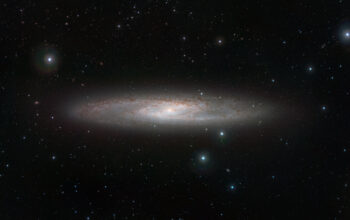The profound enigma of black holes, once relegated to the annals of theoretical astrophysics, has come into sharp focus as astronomers diligently peer into the depths of the universe. A phenomenon that challenges the very marrow of our understanding of physics, black holes function as cosmic vacuum cleaners, capturing not only light but also the very fabric of surrounding matter and time. As technological advances enhance our celestial surveillance, the phenomenon known as “tidal disruption events” (TDEs) emerges as a focal point of astronomical inquiry, shedding light on the narrative of the cosmic drain in action.
The quintessential characteristic of a black hole is its event horizon, delineating the boundary beyond which no information can escape. Imagine a vast whirlpool in the cosmic ocean, spinning relentlessly, pulling everything—including light—into its inexorable maw. When a star wanders too close to the event horizon of a black hole, this gravitational behemoth exerts tidal forces that can stretch and distort the star, frequently tearing it apart. Such encounters reveal the ferocity of black holes, illuminating the often invisible mechanics that govern their behavior.
Recently, astronomers have succeeded in monitoring a TDE in real time. This endeavor marks a significant advance in our ability to observe the interactions between black holes and stellar entities, providing tantalizing insights into the complex gravitational dance that unfolds in these extreme environments. As material from the disrupted star spirals towards the black hole, it forms an accretion disk—a radiant halo of gas and dust that liberates enormous quantities of energy, observable across various wavelengths, including X-rays and visible light.
This observation is not merely a matter of witnessing destruction; it provides a gateway into understanding black hole growth, galaxy evolution, and the interplay between dark matter and ordinary matter. Each TDE acts as a cosmic time capsule, encapsulating the conditions of the early universe and unveiling secrets shrouded in the darkness of space. By decoding the emitted radiation from these energetic events, astronomers can infer the mass of the black holes involved, the energy dynamics of the infalling matter, and even the metallicity of the host galaxy.
Moreover, the monitoring of these TDEs has unveiled significant revelations about supermassive black holes that reside at the centers of most large galaxies. These titanic and often dormant entities can become extraordinarily luminous during a tidal disruption as they consume stellar material. Such phenomena allow researchers to explore the interplay between black hole activity and star formation, shedding light on the coexistence of these massive bodies with the very galaxies they inhabit.
The fascination with black holes extends beyond their cataclysmic nature. They pose profound questions regarding the fabric of reality itself. For instance, what occurs to the information lost within the event horizon? This conundrum, often exemplified through the famous “black hole information paradox,” remains one of modern physics’ most debated topics. The question challenges established notions of determinism and inspires new theories that venture into the realms of quantum mechanics and general relativity.
Additionally, the gravitational waves emitted from the coalescence of black holes provide another lens through which astronomers examine these cosmic leviathans. Gravitational wave astronomy represents an emerging frontier that has the potential to revolutionize our understanding of the universe. By decoding the ripples in spacetime produced by black hole mergers, astronomers can gain insight into the distribution of black holes across the cosmos, their formations, and their evolutionary histories.
In the realm of theoretical models, black holes have inspired metaphors that transcend scientific jargon. They serve as a reminder of the limits of human comprehension of the universe, evoking feelings akin to staring into the abyss. The phrase “the void calls” becomes more than a literary motif; it encapsulates the insatiable human desire to probe the unknown and confront our existential questions through the lens of the universe’s most perplexing entities.
This intriguing intersection between observation, theory, and philosophy imbues the study of black holes with a unique appeal. Each discovery relating to these cosmic funnels adds a brushstroke to the grand canvas of our understanding of space and time. As telescopes become increasingly sophisticated, the horizon of knowledge expands, revealing tantalizing glimpses of realms once thought unreachable.
Indeed, the modern era of astronomy is marked by a spirited campaign of exploration, with initiatives aimed at capturing the fleeting moments of black hole activity. Projects such as the Event Horizon Telescope and space-based observatories like the James Webb Space Telescope promise to enhance the resolution of distant black holes and refine our understanding of their dynamics.
As cosmic detectives of sorts, astronomers are piecing together the puzzle of black holes, revealing their intrinsic role in the cosmic landscape. Each tidal disruption event serves as a clarion call, inviting researchers to delve deeper into the mysteries of the universe. Studying these celestial phenomena challenges our concepts of reality, urging us to reconsider the fabric of space and time in light of nature’s grandest enigmas.
In the grand theater of the Cosmos, black holes continue to captivate our imaginations and scientific rigor. The narrative of “cosmic drains” mirrors our ongoing quest for knowledge, proving that even in the darkest recesses of space, there lies potential for illumination and understanding. Such investigations cement black holes as central characters in the saga of the universe, acting not only as specters of death but also harbingers of profound consciousness.










